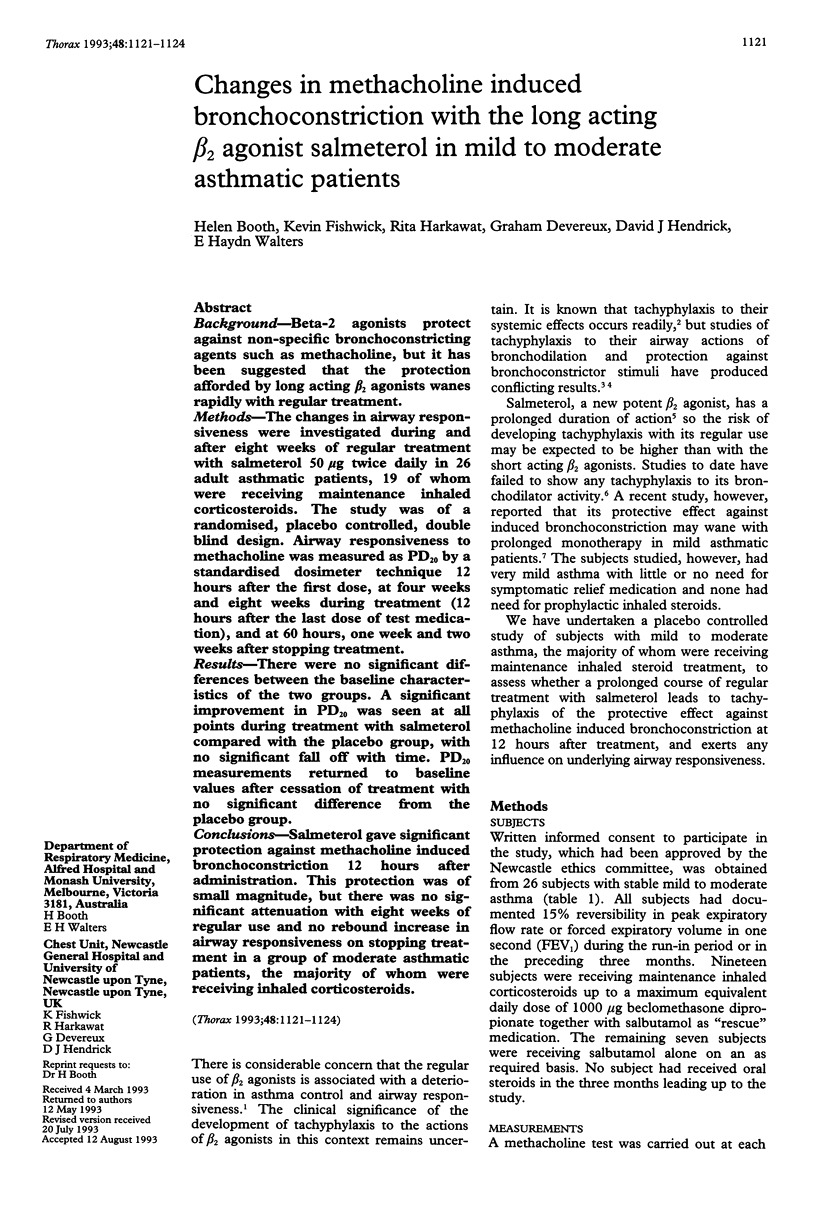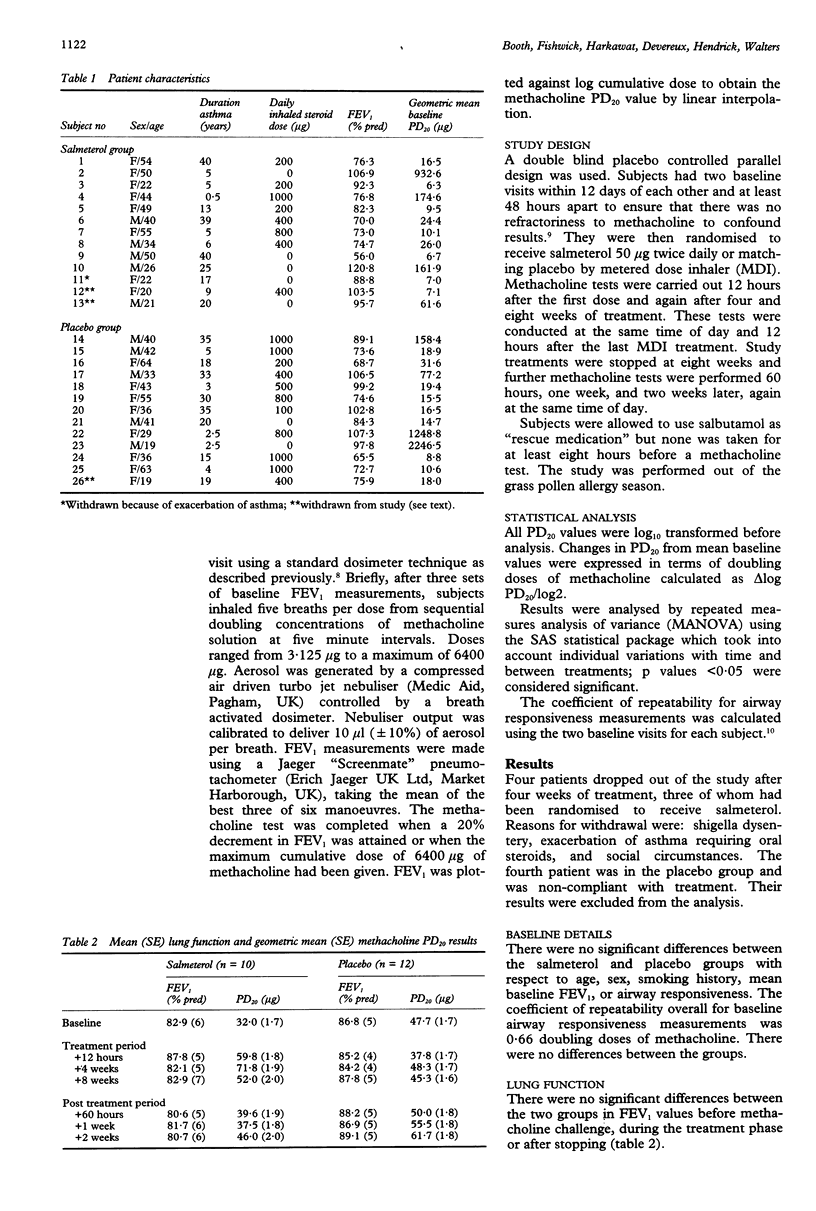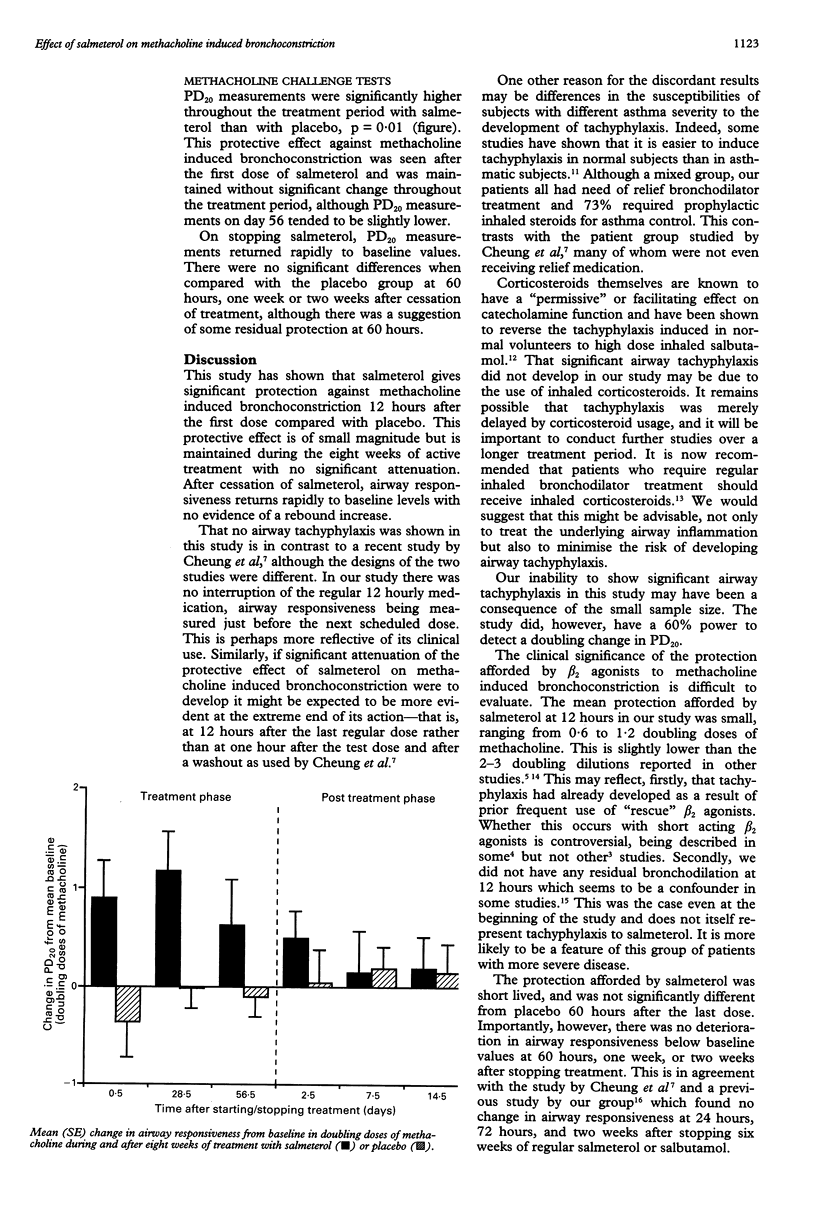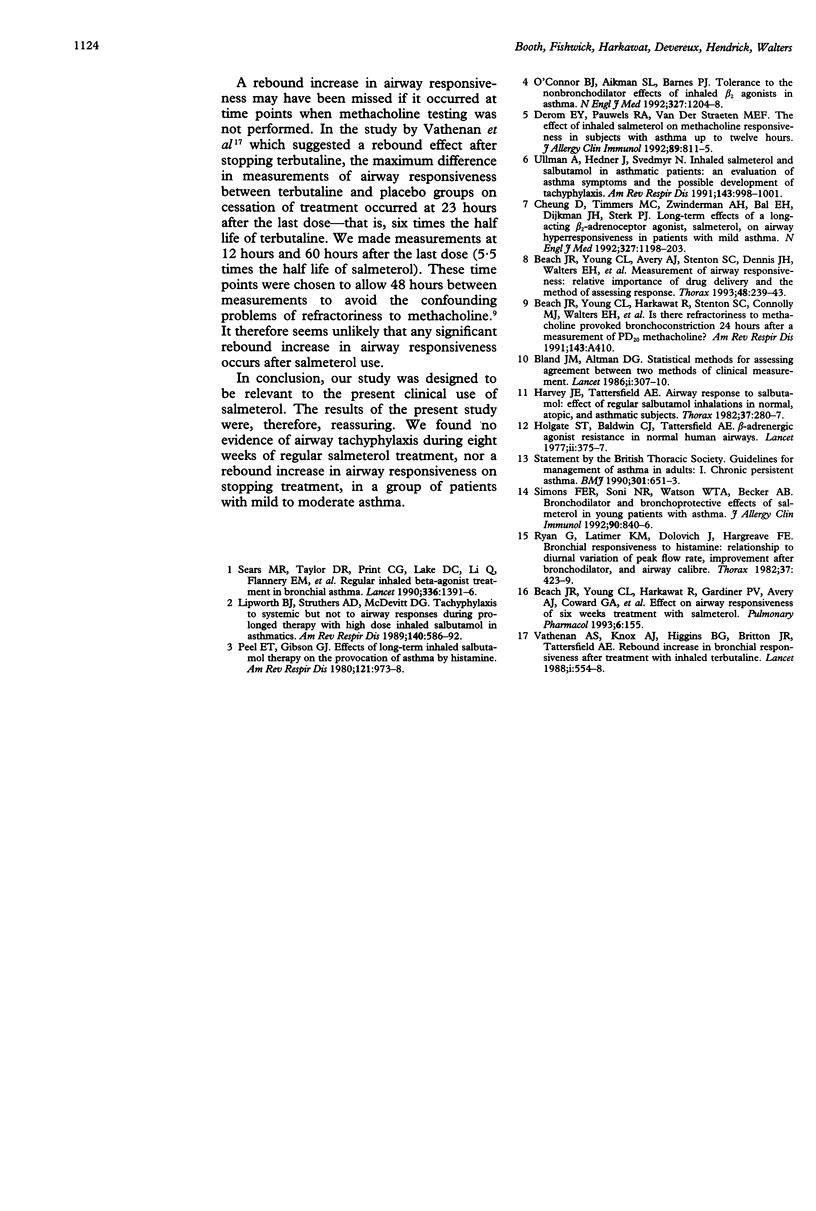Abstract
BACKGROUND--Beta-2 agonists protect against non-specific bronchoconstricting agents such as methacholine, but it has been suggested that the protection afforded by long acting beta 2 agonists wanes rapidly with regular treatment. METHODS--The changes in airway responsiveness were investigated during and after eight weeks of regular treatment with salmeterol 50 micrograms twice daily in 26 adult asthmatic patients, 19 of whom were receiving maintenance inhaled corticosteroids. The study was of a randomised, placebo controlled, double blind design. Airway responsiveness to methacholine was measured as PD20 by a standardised dosimeter technique 12 hours after the first dose, at four weeks and eight weeks during treatment (12 hours after the last dose of test medication), and at 60 hours, one week and two weeks after stopping treatment. RESULTS--There were no significant differences between the baseline characteristics of the two groups. A significant improvement in PD20 was seen at all points during treatment with salmeterol compared with the placebo group, with no significant fall off with time. PD20 measurements returned to baseline values after cessation of treatment with no significant difference from the placebo group. CONCLUSIONS--Salmeterol gave significant protection against methacholine induced bronchoconstriction 12 hours after administration. This protection was of small magnitude, but there was no significant attenuation with eight weeks of regular use and no rebound increase in airway responsiveness on stopping treatment in a group of moderate asthmatic patients, the majority of whom were receiving inhaled corticosteroids.
Full text
PDF



Selected References
These references are in PubMed. This may not be the complete list of references from this article.
- Beach J. R., Young C. L., Avery A. J., Stenton S. C., Dennis J. H., Walters E. H., Hendrick D. J. Measurement of airway responsiveness to methacholine: relative importance of the precision of drug delivery and the method of assessing response. Thorax. 1993 Mar;48(3):239–243. doi: 10.1136/thx.48.3.239. [DOI] [PMC free article] [PubMed] [Google Scholar]
- Beach J. R., Young C. L., Harkawat R., Gardiner P. V., Avery A. J., Coward G. A., Walters E. H., Hendrick D. J. Effect on airway responsiveness of six weeks treatment with salmeterol. Pulm Pharmacol. 1993 Jun;6(2):155–157. doi: 10.1006/pulp.1993.1020. [DOI] [PubMed] [Google Scholar]
- Bland J. M., Altman D. G. Statistical methods for assessing agreement between two methods of clinical measurement. Lancet. 1986 Feb 8;1(8476):307–310. [PubMed] [Google Scholar]
- Cheung D., Timmers M. C., Zwinderman A. H., Bel E. H., Dijkman J. H., Sterk P. J. Long-term effects of a long-acting beta 2-adrenoceptor agonist, salmeterol, on airway hyperresponsiveness in patients with mild asthma. N Engl J Med. 1992 Oct 22;327(17):1198–1203. doi: 10.1056/NEJM199210223271703. [DOI] [PubMed] [Google Scholar]
- Derom E. Y., Pauwels R. A., Van der Straeten M. E. The effect of inhaled salmeterol on methacholine responsiveness in subjects with asthma up to 12 hours. J Allergy Clin Immunol. 1992 Apr;89(4):811–815. doi: 10.1016/0091-6749(92)90435-5. [DOI] [PubMed] [Google Scholar]
- Harvey J. E., Tattersfield A. E. Airway response to salbutamol: effect of regular salbutamol inhalations in normal, atopic, and asthmatic subjects. Thorax. 1982 Apr;37(4):280–287. doi: 10.1136/thx.37.4.280. [DOI] [PMC free article] [PubMed] [Google Scholar]
- Holgate S. T., Baldwin C. J., Tattersfield A. E. beta-adrenergic agonist resistance in normal human airways. Lancet. 1977 Aug 20;2(8034):375–377. doi: 10.1016/s0140-6736(77)90304-x. [DOI] [PubMed] [Google Scholar]
- Lipworth B. J., Struthers A. D., McDevitt D. G. Tachyphylaxis to systemic but not to airway responses during prolonged therapy with high dose inhaled salbutamol in asthmatics. Am Rev Respir Dis. 1989 Sep;140(3):586–592. doi: 10.1164/ajrccm/140.3.586. [DOI] [PubMed] [Google Scholar]
- O'Connor B. J., Aikman S. L., Barnes P. J. Tolerance to the nonbronchodilator effects of inhaled beta 2-agonists in asthma. N Engl J Med. 1992 Oct 22;327(17):1204–1208. doi: 10.1056/NEJM199210223271704. [DOI] [PubMed] [Google Scholar]
- Peel E. T., Gibson G. J. Effects of long-term inhaled salbutamol therapy on the provocation of asthma by histamine. Am Rev Respir Dis. 1980 Jun;121(6):973–978. doi: 10.1164/arrd.1980.121.6.973. [DOI] [PubMed] [Google Scholar]
- Ryan G., Latimer K. M., Dolovich J., Hargreave F. E. Bronchial responsiveness to histamine: relationship to diurnal variation of peak flow rate, improvement after bronchodilator, and airway calibre. Thorax. 1982 Jun;37(6):423–429. doi: 10.1136/thx.37.6.423. [DOI] [PMC free article] [PubMed] [Google Scholar]
- Sears M. R., Taylor D. R., Print C. G., Lake D. C., Li Q. Q., Flannery E. M., Yates D. M., Lucas M. K., Herbison G. P. Regular inhaled beta-agonist treatment in bronchial asthma. Lancet. 1990 Dec 8;336(8728):1391–1396. doi: 10.1016/0140-6736(90)93098-a. [DOI] [PubMed] [Google Scholar]
- Simons F. E., Soni N. R., Watson W. T., Becker A. B. Bronchodilator and bronchoprotective effects of salmeterol in young patients with asthma. J Allergy Clin Immunol. 1992 Nov;90(5):840–846. doi: 10.1016/0091-6749(92)90110-n. [DOI] [PubMed] [Google Scholar]
- Vathenen A. S., Knox A. J., Higgins B. G., Britton J. R., Tattersfield A. E. Rebound increase in bronchial responsiveness after treatment with inhaled terbutaline. Lancet. 1988 Mar 12;1(8585):554–558. doi: 10.1016/s0140-6736(88)91352-9. [DOI] [PubMed] [Google Scholar]


